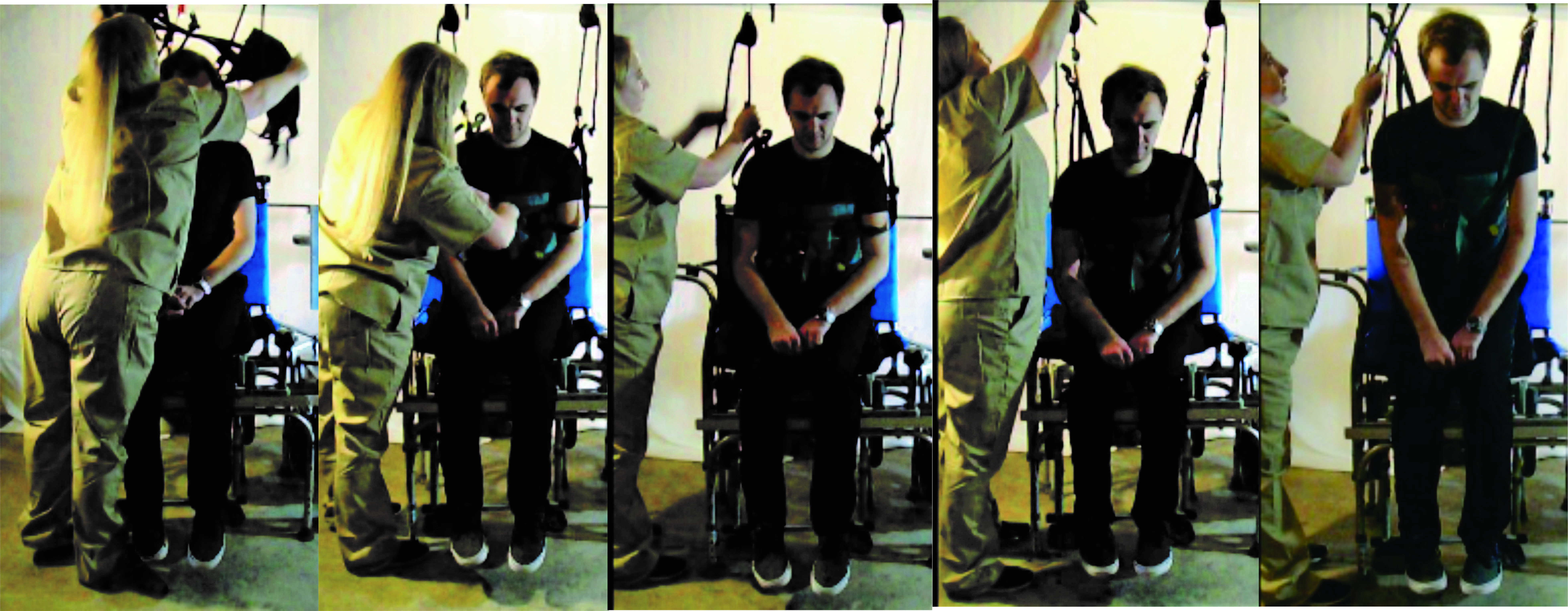Disclaimer: Aging-At-Home.org claims no medical or engineering expertise, and
seeks only to share information we have found useful with others.
Any use of the information provided is up to others, and we assume no
liability for such use. This website is for information purposes only.
This information is not provided for the purpose of diagnosing,
treating, mitigating, or preventing any type of disease, disability, or medical
condition.
Here are seven videos showing how the Aging-At-Home device works
and two videos showing how to assemble Version 2.0 of the device and
the parts used in that version.
These same seven videos
are referenced a second time below with additional
explanations preceding them.
Device
Demonstration Video - Commode Transfer.
Transferring a Person Twice the Caregiver's Weight.
Single Caregiver Transfer From a Bed to a Wheelchair.
Transfer From a Wheelchair to a Bed.
Fast (one minute) Transfer to a Commode.
Keeping
the Vest on the Person to Speed Up Transfer.
Adjusting Clothes with Ease During Commode Transfer.
To see how we used our transfer device to transfer a person from
a wheelchair to a commode (transfer to a
shower chair or mobility scooter would use a similar method),
please view the following three minute video (repeated from the Home page):
Device Demonstration Video.
One issue for caregivers is that smaller or weaker caregivers often cannot care for or transfer heavier
people. In the following video, a caregiver using the Aging-At-Home device transfers a
person over twice their weight in less than a minute.
To see how a 205 pound person can be transferred from a wheelchair to a
commode by a 100 lb. caregiver,
please view this one minute video:
Transferring a Person Twice the Caregiver's Weight.
Transfer of a fully dependent person (one who can provide little assistance
to the caregiver) from a homecare bed to a commode or wheelchair
is often a slow,
uncomfortable process. The process can cause pain, anxiety, incontinence, and lead to unnecessarily
using adult briefs.
This type of transfer also usually requires bulky
equipment and
two trained caregivers. Here we show how such a transfer can be done quickly
with a single
caregiver. Note that the room with the bed must be large enough to roll a
common homecare bed sideways about
30 inches during the transfer process. The adjustable bed should be lowered to its
minimal height (about 15 inches from the floor) making the mattress about 21
inches from the floor.
Please view the following 90 second video to see how this can be done:
Transfer From a Bed to a Wheelchair with a Single Caregiver.
Transfer from a wheelchair (or commode) back to a bed is the reverse
process of the previous video and presents many of the same challenges
to the caregiver.
Again, here we show how such a transfer can be done quickly
with a single
caregiver.
Please view the following short video showing the 90 second transfer process:
Transfer From a Wheelchair to a Bed.
Fast (one minute) transfer of dependent or disabled people to commodes is essential to avoid incontinence and the
use of adult briefs (or diapers). It is also important to be able to
quickly and easily adjust the person's clothes before and after toileting.
Please view the following one minute video to see how the
Aging-At-Home device meets these two requirements:
Fast Transfer to a Commode.
Leaving the vest (LIKOTM "Master Vest" shown below) on the disabled person during the day has some advantages.
First, it can speed up transfers by as much as a minute. This improves
the efficiency of caretakers, reduces caretaker labor, and
does not disturb the disabled person by repeatedly putting on
and taking off the vest for transfer. But another important advantage is
that the toileting process is faster, and this can reduce anxiety and
incontinence. Here is a picture of how the vest's straps attach to the
brass hooks.

The caregiver in the following video
attaches the device's brass hooks to the
vest's straps with the vest already on the disabled
person prior to transfer:
Attaching the Vest's Straps to the Transfer Device to Speed Up Transfer.
The last "transfer video" shows how fast and easy it is to adjust the
clothes of the disabled person before and after toileting when they
are being transferred to a commode using the Aging-At-Home device.
Adjusting Clothes While Transferring a Person to a Commode
We should note that many slings used with patient lifts could be used
with the Aging At Home device but these slings have not been
tested for this purpose and might require some adaptation (i.e., shortening
or lengthening of the sling's straps). The best type of sling would
probably be
a "toileting sling" with straps which wrap around the disabled person's
thighs and
require no rolling of the disabled person onto the sling in the bed prior
to transfer.
This "how to" video shows a way to build Version 2.0 of the Aging-At-Home
device in
four minutes, and it is
followed by a video review of the required parts.
Version 2.0 Build Process Video
Here is a video review of the parts required:
Version 2.0 Parts Review Video
Next we will review the site Conclusion.



